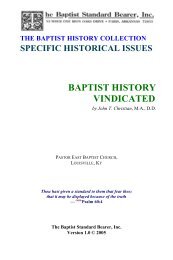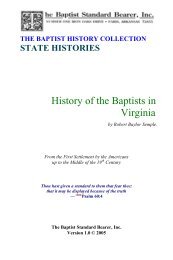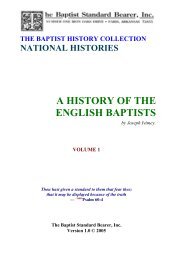- Page 1 and 2:
THE BAPTIST HISTORY COLLECTION SPEC
- Page 3 and 4:
BAPTIST CHURCH PERPETUITY OR THE CO
- Page 5 and 6:
PREFACE. Notwithstanding that many
- Page 7 and 8:
attention of the world and occasion
- Page 9 and 10:
decrees, they will be safe from the
- Page 11 and 12:
Chapter 8. — The Montanists — O
- Page 13 and 14:
opponent. — Munsterites not Bapti
- Page 15 and 16:
principles for spiritual — for ge
- Page 17 and 18:
L. L. Paine. Long. Herzog. Ridpath.
- Page 19 and 20:
CHAPTER 1. — WHAT IS CHURCH PERPE
- Page 21 and 22:
CHAPTER 2. — CHURCH PERPETUITY. A
- Page 23 and 24:
Testament, means the aggregate of t
- Page 25 and 26:
other meaning. Bretschneider (Lexic
- Page 27 and 28:
If the kingdom and the church mean
- Page 29 and 30:
(2.) Christ built His church. Wesle
- Page 31 and 32:
framed together, groweth unto a hol
- Page 33 and 34:
Adam Clarke: “Receive him into yo
- Page 35 and 36:
(c) There can be no reason why God
- Page 37 and 38:
King of Zion. f49 So far as the use
- Page 39 and 40:
Or of Kelley: Lord, thy Church is s
- Page 41 and 42:
Providential call, but no one of th
- Page 43 and 44:
CHAPTER 3. — CHURCH PERPETUITY. A
- Page 45 and 46:
There has probably never been a sup
- Page 47 and 48:
historical and Bible Church Perpetu
- Page 49 and 50:
is demonstrated. The Professor of H
- Page 51 and 52:
apostolic churches. Reader and auth
- Page 53 and 54:
“Many of the Welsh writings, whic
- Page 55 and 56:
CHAPTER 6. — THE NEGATIVE PROOF.
- Page 57 and 58:
Professor John Clarke Ridpath, Meth
- Page 59 and 60:
Waldenses, and through them a line
- Page 61 and 62:
CHAPTER 7. — IN THE PERPETUITY OF
- Page 63 and 64:
Baptist churches? “Baptist princi
- Page 65 and 66:
Against “Gnostocism, Montanism wa
- Page 67 and 68:
Spirit were to be dispensed to Chri
- Page 69 and 70:
That the Montanist churches were Ba
- Page 71 and 72:
he had not been elected bishop; tha
- Page 73 and 74:
The Novatian church government was
- Page 75 and 76:
community of saints could not fail
- Page 77 and 78:
CHAPTER 10. — THE DONATISTS. “T
- Page 79 and 80:
Munster, it would not, as in their
- Page 81 and 82:
Any one who is familiar with the pr
- Page 83 and 84:
“We clearly trace among them the
- Page 85 and 86:
As the result of the emperor’s de
- Page 87 and 88:
Child, an infidel, says: “The mem
- Page 89 and 90:
CHAPTER 11. — THE PAULICIANS. The
- Page 91 and 92:
avings of their inspired leader, th
- Page 93 and 94:
“They received all the books of t
- Page 95 and 96:
“They rejected baptism and in a m
- Page 97 and 98:
“Nothing is said by Hoveden of th
- Page 99 and 100:
“I see no reason to doubt that we
- Page 101 and 102:
Kurtz: “The little town of Albi i
- Page 103 and 104:
on nothing without the consent of t
- Page 105 and 106:
which were essentially Baptistic, w
- Page 107 and 108:
the Catharists. Let him travel in I
- Page 109 and 110:
Verona; Lorenzo or Lawrence at Serm
- Page 111 and 112:
CHAPTER 14. — THE PETROBRUSSIANS
- Page 113 and 114:
orders, and, indeed, grounds all hi
- Page 115 and 116:
would not adore images, offer praye
- Page 117 and 118:
Says Mosheim: CHAPTER 15. — THE A
- Page 119 and 120:
Baird: ecclesiastical affair’s. T
- Page 121 and 122: political f325 heresy was the sourc
- Page 123 and 124: CHAPTER 16. — THE WALDENSES. Of t
- Page 125 and 126: from their rejecting infant baptism
- Page 127 and 128: (6.) From the foregoing they agreed
- Page 129 and 130: “In this liturgy there is no offi
- Page 131 and 132: “As to baptism they said that was
- Page 133 and 134: “formerly no person was brought t
- Page 135 and 136: Says Robert Baird: “There is noth
- Page 137 and 138: CHAPTER 17. — THE ANABAPTISTS. In
- Page 139 and 140: pedobaptism.’ … ‘The visible
- Page 141 and 142: In an article in the Standard, Prof
- Page 143 and 144: “Baptism should be given to all t
- Page 145 and 146: Luther and the other reformers as t
- Page 147 and 148: scholars in his day, was drowned in
- Page 149 and 150: sin, buried with Christ, he rises t
- Page 151 and 152: on a converted membership they agre
- Page 153 and 154: ecause of the effrontery with which
- Page 155 and 156: Dr. Wall also says: “France seems
- Page 157 and 158: CHAPTER 18. — THE ANABAPTISTS AND
- Page 159 and 160: with Munzer in reference to baptism
- Page 161 and 162: once deeply imbibed, blinds the eye
- Page 163 and 164: put to a bloody slaughter for their
- Page 165 and 166: destructive fanaticism with which a
- Page 167 and 168: “The plebeian sect of the Anabapt
- Page 169 and 170: Moller: “Condemned in Rome, Monta
- Page 171: “They had not become extinct when
- Page 175 and 176: CHAPTER 20. — THE BAPTIST CHURCH
- Page 177 and 178: “Haeriticus est omnis non orthodo
- Page 179 and 180: “The Bogomiles were a branch of t
- Page 181 and 182: teachings of Peter de Bruys, and it
- Page 183 and 184: CHAPTER 21. — THE WALDENSES OF AP
- Page 185 and 186: Sylvester, 314 to 335 A.D. and acco
- Page 187 and 188: accept the testimony of the ‘Cath
- Page 189 and 190: efore Waldo, let them prove it,”
- Page 191 and 192: certain professors of church histor
- Page 193 and 194: history, with a genuine Waldensian
- Page 195 and 196: events as to deny that traditional
- Page 197 and 198: deserved his surname by residing am
- Page 199 and 200: we have demonstrated, the names are
- Page 201 and 202: Baptists. Keller insists throughout
- Page 203 and 204: (6.) While Waldo may have been the
- Page 205 and 206: CHAPTER 22. — THE WALDENSES PERPE
- Page 207 and 208: Peter de Bruis and Henry — “But
- Page 209 and 210: first propagandists on Holland soil
- Page 211 and 212: Dr. Limborch, Professor in the Univ
- Page 213 and 214: “It is well known that the Anabap
- Page 215 and 216: As explanatory, says Armitage: “A
- Page 217 and 218: Let it not be forgotten that I have
- Page 219 and 220: continued from the times of the Apo
- Page 221 and 222: There is no record of Baptists havi
- Page 223 and 224:
William R. Williams, says: “Raste
- Page 225 and 226:
enefit. Thieves and vagabonds share
- Page 227 and 228:
“History has for them no word of
- Page 229 and 230:
there were many Baptist CHURCHES in
- Page 231 and 232:
least a hundred years prior to the
- Page 233 and 234:
Queen Elizabeth reigned from 1558 t
- Page 235 and 236:
of Baptist principles are the demon
- Page 237 and 238:
(7.) Laying all this aside, I have
- Page 239 and 240:
CHAPTER 24. — JOHN SMYTH’S BAPT
- Page 241 and 242:
thereof. Now it is reason-able to c
- Page 243 and 244:
Smith Watson, and now we cannot, at
- Page 245 and 246:
Orchard’s suggestion, that Spilsb
- Page 247 and 248:
CHAPTER 25. — THROUGH WELSH BAPTI
- Page 249 and 250:
In the year 603, Augustine, called
- Page 251 and 252:
“The vale of Olchon is difficult
- Page 253 and 254:
earth can tell where the church was
- Page 255 and 256:
Says Cramp: “A church was immedia
- Page 257 and 258:
any others than Wickenden, Brown, e
- Page 259 and 260:
Armitage says: “In view of the fa
- Page 261 and 262:
No church or minister ever originat
- Page 263 and 264:
Brown, Wickenden and Dexter. … Th
- Page 265 and 266:
“The first certain date in their
- Page 267 and 268:
Massachusetts Baptist churches thus
- Page 269 and 270:
“In the year 1751, Mr. Nicholas B
- Page 271 and 272:
Christian era. … He had little ec
- Page 273 and 274:
organized before Williams’ church
- Page 275 and 276:
fellowship any who should do these
- Page 277 and 278:
(3.) To assist those members that s
- Page 279 and 280:
pleased the Lord to stir up their h
- Page 281 and 282:
“agreed that the churches should
- Page 283 and 284:
Silas Hart, 1795, died and left to
- Page 285 and 286:
letters desiring the aid of this bo
- Page 287 and 288:
“Elder James Osborne was a member
- Page 289 and 290:
As there is no difference in doctri
- Page 291 and 292:
So, without looking into their othe
- Page 293 and 294:
laid on infant baptism. … We are
- Page 295 and 296:
church. … I cannot be conscientio
- Page 297 and 298:
spiritual choice for any souls. Hen
- Page 299 and 300:
“We are surprised to learn that t
- Page 301 and 302:
In defining baptizo the American ed
- Page 303 and 304:
“That this is a mistranslation th
- Page 305 and 306:
M. T. Yates and A.B. Cabaniss are a
- Page 307 and 308:
the rate of 99 per cent.; Campbelli
- Page 309 and 310:
THE FOLLOWING FROM THE BAPTIST YEAR
- Page 311 and 312:
property, their good name, their li
- Page 313 and 314:
doctrinal or practical word, they h
- Page 315 and 316:
CHAPTER 29. — ST. PATRICK A BAPTI
- Page 317 and 318:
crowned in A.D. 1057. When Collier
- Page 319 and 320:
Thus, first, Irish monasteries were
- Page 321 and 322:
REVELATION 20:2. ROMISH CHURCH TREE
- Page 323 and 324:
FOOTNOTES ft1 In this list I have n
- Page 325 and 326:
seed.” The “invisible” notion
- Page 327 and 328:
ft95 From wieder, meaning again, an
- Page 329 and 330:
y aspersion, in the bed in whirl’
- Page 331 and 332:
ft182 Israel of the Alps, vol. 1, p
- Page 333 and 334:
ft245 Robinson’s Eccl. Researches
- Page 335 and 336:
ft300 Kurtz’s Chr. Hist., vol. 1,
- Page 337 and 338:
Proverbs 28:26; Genesis 6:5; 8:21;
- Page 339 and 340:
sunt et prudenter expenderere deben
- Page 341 and 342:
ft452 Idem, p. 124. ft453 Idem, p.
- Page 343 and 344:
ft504 Fuller’s Ch. Hist. of Brita
- Page 345 and 346:
ft549 Schaff-Herzog Ency., vol. 2,
- Page 347 and 348:
ft607 Robinson’s Reel. Resh., pp.
- Page 349 and 350:
Romish church, even permitting thei
- Page 351 and 352:
ft713 In the Globe-Democrat of 1678
- Page 353 and 354:
ft771 Idem, p. 79. ft772 Idem, p. 9
- Page 355 and 356:
ft830 Goadby’s Bye Paths to Bap.
- Page 357 and 358:
Williams’ society had dissolved;
- Page 359 and 360:
ft909 Adlam’s “First Bap. Ch. i
- Page 361 and 362:
Great Founder, Jesus Christ, than o
- Page 363 and 364:
ft963 Crosby’s Hist. Eng. Bap., v
- Page 365 and 366:
ft995 Idem, p. 27. ft996 Idem, p. 3
- Page 367 and 368:
ft1030 These views are the Bible te
- Page 369 and 370:
it does not destroy their sects. Ha
- Page 371:
ft1089 The Ancient British and Iris






